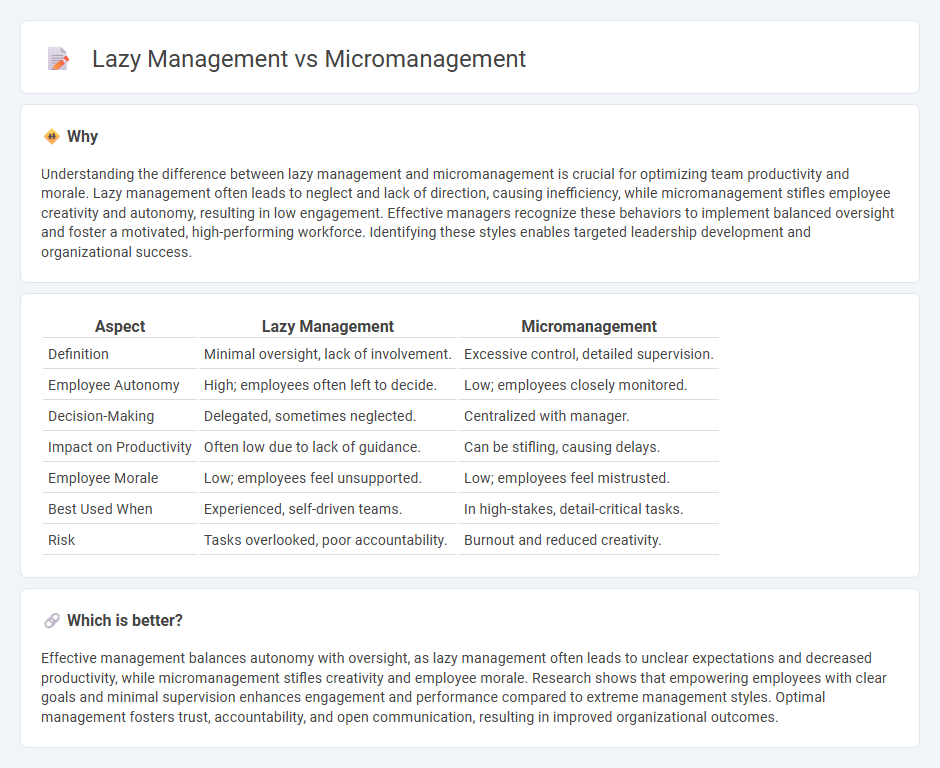
Lazy management often results in unclear expectations and lack of accountability, causing team inefficiencies and missed deadlines. Micromanagement stifles employee autonomy and creativity, leading to decreased motivation and high turnover rates. Explore effective management strategies to balance oversight and empowerment for optimal team performance.
Why it is important
Understanding the difference between lazy management and micromanagement is crucial for optimizing team productivity and morale. Lazy management often leads to neglect and lack of direction, causing inefficiency, while micromanagement stifles employee creativity and autonomy, resulting in low engagement. Effective managers recognize these behaviors to implement balanced oversight and foster a motivated, high-performing workforce. Identifying these styles enables targeted leadership development and organizational success.
Comparison Table
| Aspect | Lazy Management | Micromanagement |
|---|---|---|
| Definition | Minimal oversight, lack of involvement. | Excessive control, detailed supervision. |
| Employee Autonomy | High; employees often left to decide. | Low; employees closely monitored. |
| Decision-Making | Delegated, sometimes neglected. | Centralized with manager. |
| Impact on Productivity | Often low due to lack of guidance. | Can be stifling, causing delays. |
| Employee Morale | Low; employees feel unsupported. | Low; employees feel mistrusted. |
| Best Used When | Experienced, self-driven teams. | In high-stakes, detail-critical tasks. |
| Risk | Tasks overlooked, poor accountability. | Burnout and reduced creativity. |
Which is better?
Effective management balances autonomy with oversight, as lazy management often leads to unclear expectations and decreased productivity, while micromanagement stifles creativity and employee morale. Research shows that empowering employees with clear goals and minimal supervision enhances engagement and performance compared to extreme management styles. Optimal management fosters trust, accountability, and open communication, resulting in improved organizational outcomes.
Connection
Lazy management leads to micromanagement when leaders, avoiding strategic decision-making, compensate by overly controlling minor tasks to maintain a semblance of oversight. This behavior stems from a lack of trust in employees' capabilities, resulting in reduced autonomy and diminished productivity. Organizations experience inefficiencies as micromanagement driven by lazy leadership stifles innovation and employee engagement.
Key Terms
Oversight
Micromanagement involves excessive oversight, where managers closely control every detail of their team's work, often stifling creativity and autonomy. Lazy management, in contrast, lacks sufficient oversight, leading to unclear expectations, decreased accountability, and potential project failures. Discover how balanced oversight can enhance productivity and employee satisfaction.
Delegation
Micromanagement stifles productivity by controlling every detail, whereas lazy management neglects essential delegation, causing confusion and inefficiency. Effective delegation boosts team autonomy, accountability, and overall performance, promoting trust and skill development. Discover key strategies to balance oversight and empowerment for optimal team success.
Accountability
Micromanagement involves excessive control and close supervision, leading to accountability through constant oversight, while lazy management results in a lack of direction and responsibility, causing accountability to be often neglected. Effective accountability requires balancing clear expectations with autonomy, which neither micromanagement nor lazy management adequately provide. Explore strategies for fostering accountability without falling into these management extremes.
Source and External Links
Micromanagement - Wikipedia - Micromanagement is a management style characterized by excessive control over subordinates and an obsession with details, often leading to negative workplace dynamics.
Micromanagement Meaning and How to Deal With It - Coursera - Micromanaging involves closely supervising employees and controlling their work to a detrimental degree, often stifling creativity and morale.
8 signs you're dealing with a micromanager (and how to manage them) - BreatheHR - Micromanagement involves extreme control over employees, often driven by fear, lack of trust, or discomfort with delegation.
 dowidth.com
dowidth.com